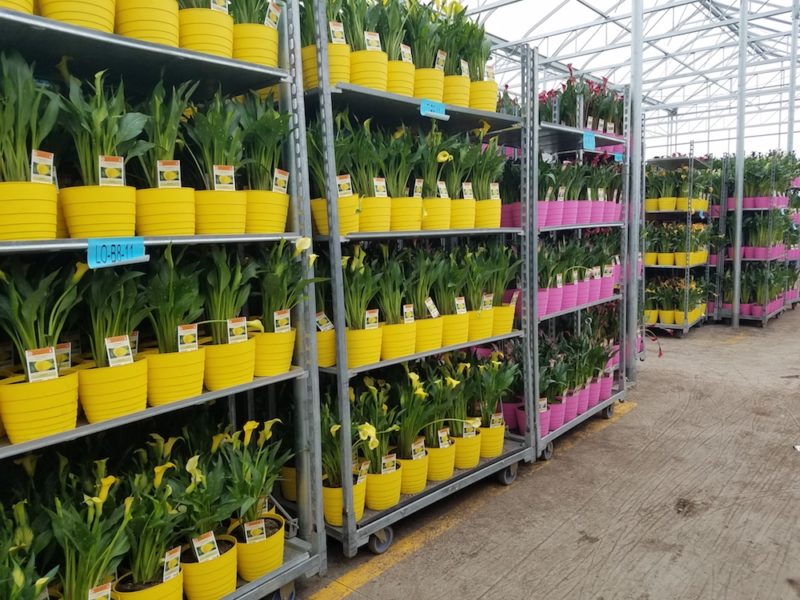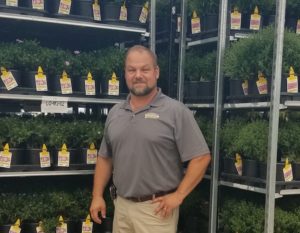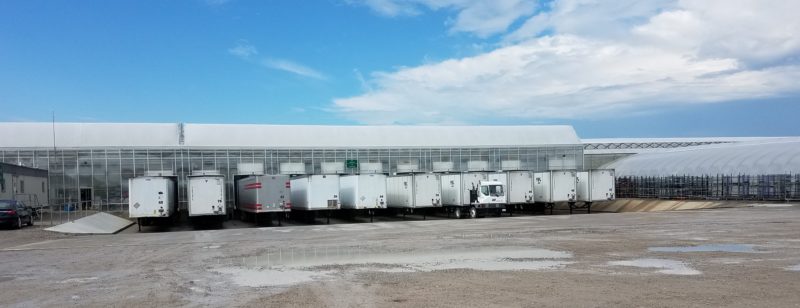
Are You Looking to Improve Your Shipping System?
What greenhouse activities account for most of your labor dollars? For many greenhouse growers shipping is where they spend most.
“Shipping can account for as much as 40 percent of the total greenhouse labor dollars,” says Gary Cortes, partner at FlowVision. “Other labor costs are divided between propagation, transplanting and plant production/maintenance. Looking at all of these activities individually, shipping is typically the biggest portion of labor for most growers.”
Cortes says shipping is usually a more complicated process than some of the other greenhouse activities.
“Product is pulled for different customers on any given day,” he says. “After the orders are pulled, depending on the growers and the customers, the plants may have to be cleaned, tagged and labeled. Then plants, whether they’re boxed or put on carts or racks, may have to be shrink-wrapped and loaded onto a truck. Compared to production processes where growers may be using a transplanting line, whether it is manual or automatic, shipping usually has more processes.”

He says the other big issue with shipping is the time constraint involved. “There is only so much time, a small window of opportunity, to ship product. Growers are usually producing in a bigger window of time than they would typically be for shipping the same product. It all depends on the region of the country where growers are located and the product they are growing.”
Growers in states with more moderate climates like Florida and California usually don’t have as drastic shipping peaks as growers in other parts of the country.
“Growers in the Midwest, North and Northeast typically have an eight- to 12-week window when 70 to 80 percent of their sales occur,” he explains. “It’s more time constrained and weather dependent. The shipping period can be condensed even more if spring comes late as it did this year. Growers have to hold the plants and then when the weather breaks, they typically have to ship a lot of product in a short time frame.”
SHOPPING THE SUPERMARKET
While many growers have set up their shipping systems to pull by order or load, Cortes says growers are seeing advantages of implementing a lean flow supermarket system that involves pulling a half day worth of product.
“Using the supermarket setup, typically a half day worth of product is brought from the greenhouse and/or field and staged in the shipping area, which is referred to as the supermarket,” Cortes says. “If a grower ships 20 trucks a day, 10 loads of product would be brought to the supermarket in the morning. The size of the shipping area determines how much product can be in the master pull.”
The most common way for setting up the supermarket is to mark the floor with a grid from 1 through X. X marks the most number of carts/ racks that will be in the supermarket at one time. The assigned number carts/racks are placed in the appropriate numbered grid on the floor.
Workers are given a shopping list (rack sheet) that tells them on which racks to pick the product. The racks are shopped in reverse drop order. The last drop is the first rack shopped. Any cleaning, labeling or tagging is done prior to the supermarket if there are no custom labels that need to be added. If a grower is selling to multiple customers with different tag and label requirements, this process is done after shopping the supermarket.

The racks are shopped and then when they are ready for loading they are set up in a grid near the loading dock. The floor is marked 1 through X with X being the number of racks that go on to a trailer. Once the racks have been filled, one final check is made to ensure everything is on the racks so they can be rolled onto the trailers.
As the product from the first master pull is being shopped, processed and loaded the pulling for the next master pull starts immediately. As workers start to empty out the supermarket they start filling it again. Inventory stays in the supermarket all day.
BENEFITS OF THE SUPERMARKET SYSTEM
According to Cortes, the savings in labor dollars for growers who have set up the supermarket system has been between 20 to 30 percent.
“We had one nursery operation that wouldn’t finish shipping until 2:30 a.m. during the peak shipping season,” Cortes shares. “After the grower implemented the supermarket system, the company was able to ship the same number of trucks and the same volume of product with the same number of people, but they finished by 6:30 p.m.”

Another benefit of the supermarket concept that some growers have seen is being able to continue to focus on production even during the peak shipping period. During the shipping season many growers feel they have to make sacrifices on the production side because they need to be focused on shipping.
“The supermarket concept optimizes the shipping process to be done more efficiently with fewer employees,” Cortes says. “The extra people are used in production. Instead of having to hire more people, a grower can use the current employees to increase their output and to use those same employees to do other jobs that normally wouldn’t get done. Instead of having to pull employees from production or another area to do shipping activities, they can be left in production.”
IMPROVING ORDER ACCURACY AND TRUCK CAPACITY
Corso’s Perennials in Castalia, Ohio, operates about 1.3 million square feet of greenhouse space and 25 acres of outdoor production. The company primarily grows perennials along with some groundcovers, ornamental grasses, herbs and annual color. Product is shipped to big box stores in 15 states. This was the first year Corso’s used the lean flow supermarket shipping system developed by FlowVision.
“The shipping system we used previously was basically pull by the order,” says Chad Corso, president at Corso’s. “Depending on the number of carts a store was receiving, the carts would be moved throughout the production facilities and loaded with the plants for the order. Then the carts would be brought back to the shipping area where the plants were cleaned and prepped and then the order was shipped out. A lot of time was spent walking around pulling the plants for the orders.”
When Corso’s switched to the supermarket system the biggest change that had to be made was learning how to move workers around from different areas to ensure the system ran smoothly.
“If workers fell behind in one area we would pull people from another area,” Corso says. “We had to learn how to be flexible to move people where they were needed most. People were able to pick up most jobs after a day or two of just working with a crew. The flexibility of the system allowed us to move people to where there were bottlenecks.”
“Employees didn’t have to learn the names of plants. Plants were identified by a number system. They followed a number system to pick orders and to bring product to the supermarket. This made the training process of new employees a lot easier.”
The optimum number of trucks that Corso’s was able to ship this year was 36 semi loads in a day. In previous years, the company was able to ship a maximum of 32 trucks in a day. This year the company averaged 32 to 36 trucks in a day during May and early June.
“We had to be patient to get our supermarket set up to make sure that all of the plants were there,” Corso says. “Once we started the picking process through the supermarket we were able to load trucks about every 20 minutes. Our 53-foot semi-trailers hold 45 carts.”
“We are using FlowVision’s Rack Item Optimizer (RIO) software with the supermarket system. The orders are optimized in RIO and the carts are full when they are picked. After the carts are picked, then the plants are scanned and go into the load staging position on the dock and they are loaded on the trailers. We’ve reduced our mistakes nearly 100 percent.”
Another benefit Corso realized with the supermarket system was how much product was going on each truck.
“Before we would pull product from two locations, bringing carts and putting them together,” Corso says. “As a result we weren’t always filling the trailers. With the supermarket system and RIO program we increased the capacity of our trucks. We were able to plan out the loads better with the picking process and using a height parameter to fill the carts through the RIO program. The capacity of our loads increased, which enabled us to deliver to more stores on a truck and to ship larger orders on a truck. We peaked out at 97 percent capacity. This year we were able to increase the capacity on each truck by 5 percent.”
CREATING AND IMPROVING THE SUPERMARKET SYSTEM
Even before Corso’s had decided to implement the supermarket concept, the company constructed a 2-acre Westbrook greenhouse to handle its shipping activities.
“We had outgrown the previous shipping facility we had been using and thought this new shipping area would be enough space,” Corso says. “We still need to add some additional outdoor concrete pad space for the empty overflow carts to be stored and organized. The carts need to be built and ready to go and stored in a location where they are not going to affect setting up the supermarket. We own about 15,000 carts and also lease some during the peak shipping season.”
Corso says one of the key factors with implementing the supermarket system is employee training.
“Prior to implementing the system we had a two-day kickoff meeting with all of our key employees,” he says. “We went through the process with them and how this system could improve work flow. We also held FlowVision’s Lean in the Green Industry Workshop. We really wanted the employees to buy into the system before it was implemented.”
Another key factor in making the system work was determining the time it would take to do each activity in a day.
“Based on the amount of time required to do different activities enabled us to design a plan for how many employees we would need,” Corso says. “Even though we estimated how many people we’d need, don’t expect to get it right until you’re into the spring shipping season. This helped us to better understand where we could make improvements and where we were wasting time on things that weren’t going as planned. In the beginning of the process, you have to have patience since this is a new concept. But every day you have to strictly stick to the supermarket plan or you can create your own inefficiencies. We are going to continue working on the system with additional organizing, training and supervision.”
For more information: Gary Cortes, FlowVision, 561.301.8740, cortes@flowvision. com, www.flowvision.com; Corso’s Perennials, 888.816.8608, chad@corsosperennials.com, www.corsosperennials.com.


 Video Library
Video Library 




















